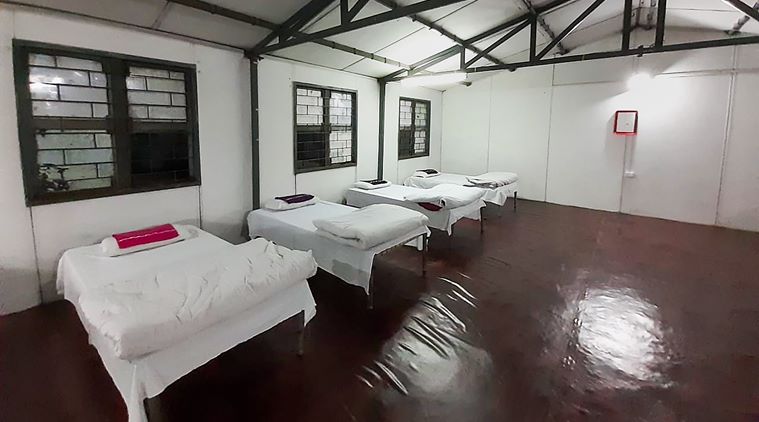Explained: Amid the coronavirus pandemic, here’s how home quarantine works
The government has issued guidelines on home quarantine for people who have been exposed to novel coronavirus. What are these guidelines, and how is this regime different from being quarantined in an Army facility?
 Home quarantine is less restrictive than quarantine in an Army facility such as the one in Manesar (above), where a number of Indian nationals back from Wuhan were quarantined and eventually tested negative for coronavirus. (Express Photo: Gajendra Yadav)
Home quarantine is less restrictive than quarantine in an Army facility such as the one in Manesar (above), where a number of Indian nationals back from Wuhan were quarantined and eventually tested negative for coronavirus. (Express Photo: Gajendra Yadav)
In India’s fight against the novel coronavirus disease (COVID 2019), the Union Health Ministry has issued elaborate guidelines on how to enforce “home quarantine” for a fortnight. While less stringent than being quarantined in an Army or paramilitary facility, home quarantine comes with its own set of restrictions. Here is all you need to know about such a regime, and why it is important.
Coronavirus outbreak: What is home quarantine?
Quarantine, like isolation, separates some people from others during the outbreak of a contagious disease. While isolation separates sick people from people who are not sick, quarantine separates those who were exposed to a contagious disease, and who are then observed to see if they too become sick. Home quarantine means being quarantined at home.
How is home quarantine to be done?
Home quarantine means that a person is confined to a well-ventilated single-room, preferably with an attached/separate toilet, in his or her own home. If another family member needs to stay in the same room, the two need to maintain a distance of at least 1 metre between each other.
Given the enhanced risks for some people, the person needs to stay away from elderly people, pregnant women, children and persons with co-morbidities within the household. In the coronavirus outbreak, children have so far been less affected than others — in China only 2% of the patients have been below age 20. However, given the fact that this virus is essentially an unknown organism, the government’s home quarantine guidelines highlight the need for a contact to stay away from children as well.
 Coronavirus outbreak: At the quarantine facility in Manesar on February 18, 2020. (Express Photo: Gajendra Yadav)
Coronavirus outbreak: At the quarantine facility in Manesar on February 18, 2020. (Express Photo: Gajendra Yadav)
All social or religious gatherings have to be avoided during the 14-day period. The person should not share any items such as dishes, drinking glasses, cups, eating utensils, towels, bedding, etc with other people at home and should wear a mask at all times. “Masks used by patients / care givers/ close contacts during home care should be disinfected using ordinary bleach solution (5%) or sodium hypochlorite solution (1%) and then disposed of either by burning or deep burial,” read the guidelines prepared by the directorate general of health services.
📢 Express Explained is now on Telegram. Click here to join our channel (@ieexplained) and stay updated with the latest
Is home quarantine known to control spread of a disease?
Officials associated with the detection and surveillance of COVID-19 say that home quarantine has so far turned out to be a very effective means of infection control. “To tell a person that the consequences of any laxity in observation of the quarantine protocol would mean his or her being the means of infection of a family member is usually the most effective means of ensuring compliance. People are extra careful,” an official said.
However, here’s the catch. If a person has successfully completes the 14-day quarantine without contracting the disease, resumes normal life and comes in contact once more with a COVID-2019 patient, there will then arise the need to follow another fortnight of home quarantine, said Dr R R Gangakhedkar, head of the division of epidemiology and communicable diseases, Indian Council of Medical Research.
Who needs to be in home quarantine?
Every person who has come in contact with a suspected or confirmed case of COVID-2019 needs to be in home quarantine. This is not only because the disease is highly contagious but also because the virus has an incubation period of 14 days during which a person may stay asymptomatic and yet be capable of spreading the virus.
 Coronavirus outbreak: At the Manesar facility, patients are quarantined for at least two weeks before being discharged. (Express Photo: Gajendra Yadav)
Coronavirus outbreak: At the Manesar facility, patients are quarantined for at least two weeks before being discharged. (Express Photo: Gajendra Yadav)
A contact of a COVID-2019 patient is defined as:
🔴 A person living in the same household as a COVID-19 case;
🔴 A person having had direct physical contact with a COVID-19 case or his/her infectious secretions without recommended personal protective equipment (PPE) or with a possible breach of PPE
🔴 A person who was in a closed environment or had face to face contact with a COVID-19 case at a distance of within 1 metre including air travel.
What precautions are necessary for family members of a person in home quarantine?
To minimise the number of people in a family who come in contact with a person with possible-COVID 2019 exposure, only one designated family member, who needs to wear a mask and gloves at all times, should be the caregiver. All physical contact should be scrupulously avoided, including sharing of linen. Visitors are not to be allowed. “In case the person being quarantined becomes symptomatic, all his/her close contacts will be home quarantined (for 14 days) and followed up for an additional 14 days or till the report of such case turns out negative on lab testing,” say the guidelines.
 A view of the quarantine facility which has been set up by the Army in Manesar, Haryana on January 31, 2020. (Twitter/PTI Photo)
A view of the quarantine facility which has been set up by the Army in Manesar, Haryana on January 31, 2020. (Twitter/PTI Photo)
A very important aspect of the process of home quarantine is disinfection and cleaning of all surfaces possibly contacted by the person with 1% sodium hypochlorite solution. Toilet surfaces have to be cleaned with phenolic disinfectants or other household bleaching solutions. Clothes have to be washed separately.
How is all this less restrictive than being put in quarantine in an Army facility?
Being quarantined in one’s own home is always better than staying with strangers at an Army or paramilitary facility. Besides the daily medical examinations, there are also other restrictions. Apart from playing games, watching TV and having meals together within a barrack, no one is allowed to interact with the members of another barrack and definitely not another sector for fear of infection. As one person who had come out of one of the facilities had said, it is like being in the Big Boss House.
Don’t miss from Explained | The coronavirus dictionary: The meanings to words you are hearing a lot
- 01
- 02
- 03
- 04
- 05






































